04 Dec 12
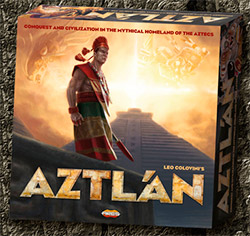 My most recent boardgame graphic design job has hit the shelves: Aztlán by Italian publisher Ares Games (BoardgameGeek link). Like my last project of this type, Ninjato, I was lucky enough to be asked to work with evocative images by illustrator Drew Baker.
My most recent boardgame graphic design job has hit the shelves: Aztlán by Italian publisher Ares Games (BoardgameGeek link). Like my last project of this type, Ninjato, I was lucky enough to be asked to work with evocative images by illustrator Drew Baker.
It was also a pleasure working closely with Roberto Di Meglio, one of the designers of an all-time favourite game of mine, War of the Ring, and a director of Ares Games.
On this job my responsibilities were to design and create the print ready art for the game box (including the logo of course), the rulebook, the board, and various sets of cards. A lot of the heavy lifting had already been done by the illustrator, and I consciously chose not to detract from the illustrator’s work with too much in the way of fiddly extra graphics, so the challenge was to bring everything together into a unified design package.
The starting point is always the logo. The game is based on the mythological land of the Aztecs, so I went for a monolithic feel, enhanced by some photographic stone textures of Mayan ruins I had taken many years ago during a trip to Mexico. I wanted something bold and readable and reflective of the shapes of Aztec ziggurats, and the typeface Recovery worked well as the basis for the logotype—strong and evocative, yet with a contemporary edge. My only ‘design indulgence’ was the placement of the accent over the A, which cuts into the letter below it.
For the board, I added the logo and scoring track in the same style as the illustration, plus the icons for different terrain types, among other things. The icons were modified from an initial set done by an Ares Games designer, which I added to, changed and recreated and then made them look carved from various materials used by the Aztecs—jade, silver, copper and gold. The card designs featured these icons, more stone textures, and the typeface Paralucent Text, which gave me the distinctive yet very readable look that felt right. Again, I tried to keep these cards as free of extra text and unnecessary clutter as possible and simply feature the stunning art, and I think this design sensibility carries across the entire game nicely.
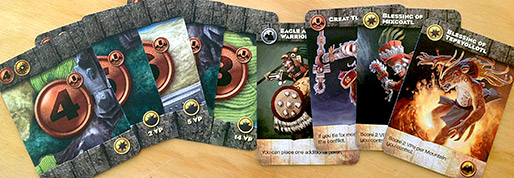
A big project was the rulebook, which is full of detailed examples of play and took quite a bit of work. This involved elements of Drew’s illustrations, with some textural modifications of my own (note, for example, the different types of ‘splatters’ that help deep-etch the illustrated characters in interesting and dynamic ways). As usual, the design was carefully examined over and over and repeatedly tweaked so the layout read as well as possible.
Aztlán is available online or at your usual games retailer now. It’s an elegant and clever design by Leo Colovini (Cartagena, Clans, Inkognito, Atlantis) with some fascinating twists—I particularly like the way the victor in a battle can choose to conquer his enemy or peacefully coexist with him (to receive a ‘prosperity card’ in return). Ares Games have done a wonderful job on the production, particularly with the plastic box insert, the colourful plastic tribe pawns and the ingenious score markers, which stack together into a ziggarat when you go above 100 points.
I really enjoyed working on this one and hope you enjoy playing it!
PS Of course, you can find a rules summary for the game here.
Board & Miniatures Games, Design
22 Nov 12
Some more updates on the Universal Head Boardgame Summary Sheets page:
 Betrayal at House on the Hill now has a completely revised, all-in-one game aid booklet that includes a rules summary, a set of character cards to put players in the mood, 3 versions of the Haunt Chart, and the revised and corrected Haunts plus the extra 20 Haunts offered online by the original designer (for a total of 70 unique Haunts!) All the Haunts have been painstakingly formatted to match the graphic style of the game. Note this is all for the original version of the game, not the revised version!
Betrayal at House on the Hill now has a completely revised, all-in-one game aid booklet that includes a rules summary, a set of character cards to put players in the mood, 3 versions of the Haunt Chart, and the revised and corrected Haunts plus the extra 20 Haunts offered online by the original designer (for a total of 70 unique Haunts!) All the Haunts have been painstakingly formatted to match the graphic style of the game. Note this is all for the original version of the game, not the revised version!
 My latest major boardgame graphic design job was Aztlan for Ares Games. Since War of the Ring is one of my favourite games, it was an honour to do the graphic design for Roberto di Meglio, not to mention work with illustrator Drew Baker of Ninjato fame again. The game, which is set in the mythological homeland of the ancient Mexican peoples, features simple but ingenious rules that I’ve summarised in this new sheet.
My latest major boardgame graphic design job was Aztlan for Ares Games. Since War of the Ring is one of my favourite games, it was an honour to do the graphic design for Roberto di Meglio, not to mention work with illustrator Drew Baker of Ninjato fame again. The game, which is set in the mythological homeland of the ancient Mexican peoples, features simple but ingenious rules that I’ve summarised in this new sheet.
 Set in FFG’s cyberpunk Android universe, Infiltration is a fast, fun, push-your-luck game about operatives breaking into a high-tech facility to steal data files. Hmmm… why don’t they just use the internet? Oh well, it’s a great little game and captures the theme well. New rules summary and reference sheet.
Set in FFG’s cyberpunk Android universe, Infiltration is a fast, fun, push-your-luck game about operatives breaking into a high-tech facility to steal data files. Hmmm… why don’t they just use the internet? Oh well, it’s a great little game and captures the theme well. New rules summary and reference sheet.
Finally, my sheet for Ninjato has had some minor rewording to make it clearer.
Enjoy!
Board & Miniatures Games Reference Sheets
16 Nov 12
Last weekend I set off for another weekend of boardgaming, this time to Hamilton for its Boardgames by the Bay event. Unfortunately there is no direct flight from Nelson, so I changed planes at Wellington, where the terminal is dominated by a huge Gollum, diving through the celing to grab for some deliccioussss fissshhheeesss …
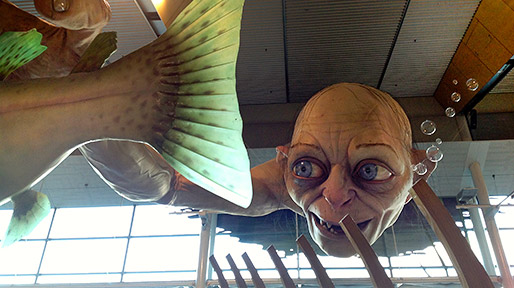
I met up with my NZ boardgaming buddy Minty and his son Sam and the three of us flew on to Hamilton, about 100 kms south of Auckland. Hamilton doesn’t really have too much going for it unfortunately; it’s a tired-looking city of 200,000 for which none of the locals really had anything too positive to say. Luckily, however, we weren’t there for the sightseeing, we were there for the boardgaming—and that was in plentiful supply.
The event was organised by the estimable David Taylor of Seriously Board, who as usual worked his fingers to the bone making sure everyone was having a good time. The venue was a comfortable contract bridge club just outside of town (though I do wish these events were a bit closer to shops, food and bars) with a kitchen and plenty of parking. A respectable number of gamers played all manner of games over the weekend, though unfortunately quite a few people seemed to leave early on Saturday night, perhaps due to the demands of children.
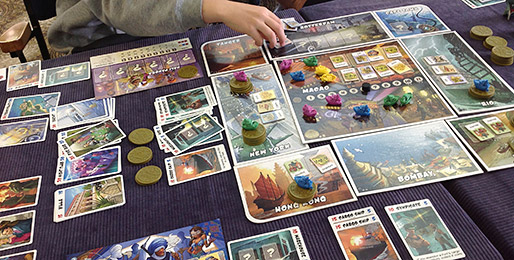
Anyway, I got about nineteen games in over the weekend, running the usual gamut from the incredibly fun (Infiltration, Family Business, Cosmic Encounter) to the ‘meh’ (Flash Point, London, Sentinels of the Multiverse). The friendly Star Wars: X-Wing Miniatures Game tournament was a highlight; four successive games of this new Wings of War-like game that saw some hilarious moments, especially, in one game, when Darth Vader went crashing into an asteroid instead of joining the fight—luckily his Determination ability and a lucky card draw saw him shrug off the damage and swoop in for the Rebel kill!
I also must mention the wonderful hospitality of Tim and Jacqui, who played host to Minty, Sam and I for both nights (and two other gamers on Friday night). Thanks guys!
Where the eponymous ‘bay’ is, however, I have yet to discover …
Board & Miniatures Games
06 Nov 12

JoJo was in a store with a friend of ours and their kids the other day, and one of those Xbox Kinect machines was hooked up. Of course it wasn’t long before they were all flailing about in front of the screen copying the dance moves. When she got home I was amazed—nay, stunned—when she said “I’m going to get one of those”. I’d known about the Kinect for a while of course, but dismissed it as a ‘kid’s game’. But when your girlfriend—who has previously expressed no interest in computer games—offers to pony up to get the system, you don’t start arguing.
So we went and jumped about in the shop, both pronounced it lots of fun, and got the sensor (I already have an Xbox 360 of course). After some deliberation and a bit of research, we also purchased Just Dance 4. And JoJo threw in Fable: The Journey for me as well so I could try some ‘spellcasting’.
This is another one of those things we couldn’t have done back in Sydney, with our tiny TV room in our tiny inner-city terrace, so it’s great to be able to spread out and have plenty of space to flail about in front of the TV, perfecting our dodgy dance moves in time with crappy pop music. And, despite my misgivings about being forced to listen to some of the worst music this side of, well… anywhere, it’s a hell of a lot of fun. So much fun, that I even managed to sprain one of my toes last night as I jumped about!
I was never a big dancer, though being a drummer I had enough rhythm and coordination to avoid making a fool of myself and enjoyed going out to dance occasionally. What’s interesting here is how the brain quickly makes sense of the whole Kinect setup, and it doesn’t take long before the muscle memory kicks in and you’re remembering the dance moves, matching the left and right of your body to the left and right of the figure on the screen, and racking up the ‘PERFECT!’ scores. Of course Just Dance 4 is apparently one of the more forgiving and encouraging in the pantheon of Kinect dance games, so that might have something more to do with the good scores.
The thing has been a huge hit for us and hilarious fun. It’s also surprisingly good exercise. I thought I was in OK shape, but a few songs jumping about soon had me collapsing on the couch struggling to catch my breath. And after you’ve hopped, posed, punched the air and jogged to Rick Astley’s Never Gonna Give You Up, you can replay bits of video and animated picture sequences that lovingly record how ridiculous you both look.
When it comes to ‘proper’ gaming however, the Kinect probably has a product generation or two to go. Fable: The Journey is gorgeous-looking and very well made, but the accuracy isn’t consistent yet, and the gameplay is very much ‘on rails’. Still, there is a lot of fun to be had waving your arms blasting fireballs and grabbing and throwing goblins into the air in the combat sequences, even if it is frustrating pushing your hand out towards one part of the screen and having the fireball go blasting off into the opposite corner… over and over again. Less fun is to be had sitting watching your horses’s rump as you guide your cart along the road, pulling one rein or the other to direct your movement.
Quite apart from the restrictions of the Kinect, Fable: The Journey has the usual problems typical of computer games—annoying characters, cliched Tolkien-meets-Star-Wars plots, grating voice acting, a lack of wit in the writing… but I suppose it is geared towards a younger audience.
Still, there are glimpses of the future we saw in Minority Report here, and while the Kinect experience can be truly frustrating sometimes, it can also be a whole new kind of fun. It will be fascinating to see how the technology develops in the future.
In the meantime… EVERYBODY DANCE NOW!
Computer Games
29 Oct 12
Now and then I still get a chance to update old game sheets and create new ones; here are the latest updates on the Universal Head Boardgame Summary Sheets page:
 Thanks to the help of BattleLore fan Damon Usher, I’ve finally updated this sheet to include everything that has ever been released for this classic (we can call it classic now, right?) game. Unless Fantasy Flight Games actually does something with BattleLore, this should be the definitive version of this summary and reference sheet collection.
Thanks to the help of BattleLore fan Damon Usher, I’ve finally updated this sheet to include everything that has ever been released for this classic (we can call it classic now, right?) game. Unless Fantasy Flight Games actually does something with BattleLore, this should be the definitive version of this summary and reference sheet collection.
 Descent has never made it to the table enough, mostly due to its incredible long playing time, which has made it somewhat of a byword for long, exhausting game sessions. But Fantasy Flight has cleverly listened to the feedback and rebooted their own franchise with Descent 2nd Edition, and the new the game is the fast-playing, fun dungeoncrawler it always wanted to be. Shame about all the work I put into those 1st edition sheets…
Descent has never made it to the table enough, mostly due to its incredible long playing time, which has made it somewhat of a byword for long, exhausting game sessions. But Fantasy Flight has cleverly listened to the feedback and rebooted their own franchise with Descent 2nd Edition, and the new the game is the fast-playing, fun dungeoncrawler it always wanted to be. Shame about all the work I put into those 1st edition sheets…
 This B-movie haunted house romp is pretty standard fare until the ‘haunt’ kicks in, and one of 60 unique plots pits one of the players as the Traitor against the others. My rules summaries, character cards and redesigned Haunt Chart are unchanged, but my redesigned Secrets of Survival and Traitor’s Tome booklets (with the Avalon Hill-corrected text) have finally been updated with the bonus 10 plots that were released later. Remember this is all for the original version of the game, not the revised version.
This B-movie haunted house romp is pretty standard fare until the ‘haunt’ kicks in, and one of 60 unique plots pits one of the players as the Traitor against the others. My rules summaries, character cards and redesigned Haunt Chart are unchanged, but my redesigned Secrets of Survival and Traitor’s Tome booklets (with the Avalon Hill-corrected text) have finally been updated with the bonus 10 plots that were released later. Remember this is all for the original version of the game, not the revised version.
 A stand-alone deck-building card game set in Fantasy Flight Games’s Runebound generic fantasy universe. A slick little design with a perfect mixture of conflict and strategy that’s fast playing and fun. Version 2 of my summary and reference fixes a small error and adds the rules from the new expansion Oath and Anvil.
A stand-alone deck-building card game set in Fantasy Flight Games’s Runebound generic fantasy universe. A slick little design with a perfect mixture of conflict and strategy that’s fast playing and fun. Version 2 of my summary and reference fixes a small error and adds the rules from the new expansion Oath and Anvil.
 Lovecraftian sanity-blasting goings-on from the makers of Arkham Horror, but with more of a storytelling emphasis. Like little games of the Call of Cthulhu roleplaying game without all the time and preparation. Now updated to include the Forbidden Alchemy expansion.
Lovecraftian sanity-blasting goings-on from the makers of Arkham Horror, but with more of a storytelling emphasis. Like little games of the Call of Cthulhu roleplaying game without all the time and preparation. Now updated to include the Forbidden Alchemy expansion.
Also updated in the last few months: Mall of Horror, the Man O’ War ship cards, Runewars, and Ticket To Ride: Switzerland.
Board & Miniatures Games Reference Sheets
21 Oct 12
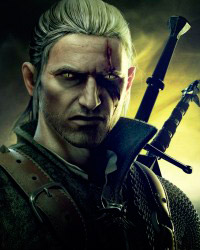
Yes, I’m angry too
The Witcher and The Witcher 2 get high praise from PC video gamers as being complex, immersive, adult-oriented RPGs. By the way, I always find it amusing when these games are called ‘RPGs’—roleplaying this is not, and despite the occasional moral decision or choice of endings, they hardly come within an orc’s roar of the possibilities of real roleplaying games. Anyway, I digress. My message here is to Mac video gamers.
I first attempted to play The Witcher via Valve’s game distribution system Steam, and the game did nothing but crash my computer. I tried all kinds of technical mucking about to get the thing to work, doing the usual trawl through forums and websites and following arcane instructions, but no luck. I also discovered that the game wasn’t even a proper port, but simply stuck in some middle-man emulation wrapper. Though they happily take my money, Steam take no responsibility for anything they sell actually working; but after complaining enough I eventually convinced them to credit my purchase (it was only $10) and bought Faster Than Light instead (a fun little game by the way).
I know, I should have learned my lesson, but the release of The Witcher 2 for Mac the other day tempted me to try once more. This time—since I’ve vowed never again to use Steam—I bought and downloaded it from GOG.com for a bit over $20. Lucky it was cheap, because despite the fact it actually does work and play this time, I’m not happy with its performance. On my brand new 2.6Ghz quad-core Intel Core i7 MacBook Pro with retina display, 16Gb RAM and 1024Mb NVIDIA GeForce graphics card, I can’t get anywhere near a decent frame rate with high quality graphic settings; a particularly annoying quality when you’re trying to make quick clicks with a stuttering mouse cursor during combat. It’s certainly playable, and can still be graphically impressive, but I have to set the screen size and quality settings to ‘low spec’.
Low spec? That’s just ridiculous. While PC gamers scoff at Mac graphic cards, it’s not because the Mac isn’t capable of handling games like this. I played Call of Duty 4 on this machine, full screen at 2560 x 1440 and 16:9, with every setting completely maxxed out, and it looked incredible and played smoothly, even in the most complex battle scenes. Why can’t The Witcher 2 work as well?
Another annoyance is that you have to completely quit the game and start again if you want to tweak the graphic settings—making the process of optimising your game far more time-consuming and difficulty than it should be.
So if you’re a Mac user and you’re tempted by either of these games, take my advice—forget the first one, and take a long hard look at your Mac specs before buying the second. Anything less than a top-of-the-line Mac and I think you’ll be greatly disappointed, and even then the really good graphic settings seem out of reach. I predict we’re about to see a lot of complaints about the practical playability of this new port. Personally, I’m fed up with publishers taking advantage of Mac gamers by releasing sub-standard Mac versions—no doubt relying on enough quick sales to justify the effort before word gets around.
Computer Games
19 Oct 12
 As part of the Nelson Arts Festival, last night at Nelson’s Theatre Royale we saw a live treatment (complete with band, actors and foley artist) of the 1962 B-movie horror classic, Carnival of Souls. It was remarkably good.
As part of the Nelson Arts Festival, last night at Nelson’s Theatre Royale we saw a live treatment (complete with band, actors and foley artist) of the 1962 B-movie horror classic, Carnival of Souls. It was remarkably good.
I saw the original film quite a few years ago and was struck by how well made it is; despite the slow pace and the predictable plot (especially for modern audiences), the direction and cinematography have given the film cult classic status, influencing directors such as Lynch and Romero. Made on a shoestring budget in three weeks and ignored at the time of release, it’s a great shame the director Herk Harvey never made another feature.
This presentation took the film to whole new heights, with a clever new score by Leon Radojkovic performed live by an excellent band, and four accomplished actors playing all the roles. Chelsie Preston Crayford, who voiced Mary (the stunning Candance Hilligoss) was particularly excellent. Gareth Van Niekerk pulled off foley (sound effects) duties from his solitary booth at the side of the stage, covering everything from footsteps to jangling keys to gurgling water.
I was particularly impressed by the way the original script wasn’t changed and the actors didn’t ham it up too much, beyond a few extra “hmmmms” and some exaggerated accents. It struck a good balance between being entertaining, sometimes funny, and yet largely preserving the original integrity of the film—even increasing the mild scares of some scenes with some well-timed musical stabs and creepy organ themes.
A fantastic night out in Nelson, enhanced by the stress-free pleasure of easy parking close to the venue, something we Sydney escapees still find a joy. You can get a taste of the performance here.
Theatre
15 Oct 12
 If you, like me, spent a good chunk of your formative years pitting your friends against horrific monsters, sending them into dank dungeons, inflicting damage, disease and insanity upon them, and generally acting like God on (Middle-) Earth, then I hope you too were playing Dungeons & Dragons and aren’t instead a rank psychopath now paying for your terrible crimes. A lot of people born in the sixties and seventies were doing the same, or the subjects of similar imaginative abuse as adventuring characters in a fantasy, sci-fi or historical world. D&D, and the many roleplaying games it spawned, were a big fad of the late 70s and 80s; but a fad with a far bigger impact on people’s lives than twirling a hula–hoop or spinning a yo-yo. There’s been nothing quite like role-playing games, before or since, and anyone who spent any serious time playing them will understand what I mean.
If you, like me, spent a good chunk of your formative years pitting your friends against horrific monsters, sending them into dank dungeons, inflicting damage, disease and insanity upon them, and generally acting like God on (Middle-) Earth, then I hope you too were playing Dungeons & Dragons and aren’t instead a rank psychopath now paying for your terrible crimes. A lot of people born in the sixties and seventies were doing the same, or the subjects of similar imaginative abuse as adventuring characters in a fantasy, sci-fi or historical world. D&D, and the many roleplaying games it spawned, were a big fad of the late 70s and 80s; but a fad with a far bigger impact on people’s lives than twirling a hula–hoop or spinning a yo-yo. There’s been nothing quite like role-playing games, before or since, and anyone who spent any serious time playing them will understand what I mean.
Now I’m really, really late to the party (this whole thing kicked off about four years ago), but something called the OSR (‘Old School Renaissance’) is in full swing. Actually, in a way I was a bit of a pioneer personally and professionally in this respect, because I had a D&D nostalgia trip about ten years ago, when I re-bought the old books and adventure modules on Ebay that I’d so foolishly sold in my late 20s, thinking “I’d never play that stuff again.” And if I may present my other credential, I created the website The World of Tékumel back in 1997 to celebrate the first roleplaying game I ever played: Professor M.A.R. Barker’s The Empire of the Petal Throne. That’s about as old school as you can get.
Like most things that are an integral part of one’s formative years, D&D has a magic about it that never really goes away. My friends and I very, very occasionally get together to play Warhammer Fantasy Roleplay, a similar role-playing game set in the Empire of the Warhammer universe, but the original versions of D&D are a differently thing entirely, with a special atmosphere that the proponents of the OSR love to celebrate.
 We’re not talking about anything published ‘officially’ during the last couple of decades of increasing commercialisation and steadily encroaching blandness, of bad movies and cartoons and licenced toys, or of versions 2, 3, 3.5 (argh!), 4, and what is currently called D&D Next (triple argh!). We’re talking about three very early systems—the original ‘white box’ rules (just before my time), the old Basic Dungeons & Dragons sets (the original by J. Eric Holmes is where I came in—you can see the rulebook cover on the right), and the first edition Advanced Dungeons & Dragons hardcovers (‘AD&D’—the system I played the most). We’re talking everything up to about 1984, when the Dragonlance adventure modules came out and the original pulp science-fantasy origins of D&D began to be replaced by a kind of bland ‘American Tolkien’ fantasy melieu of buffed heroes, chainmail bikinis and Big Bad Guys. No, we’re talking getting a fighter, magic-user, cleric and thief together and descending into some monster-infested dungeon in search of gold pieces and magic items.
We’re not talking about anything published ‘officially’ during the last couple of decades of increasing commercialisation and steadily encroaching blandness, of bad movies and cartoons and licenced toys, or of versions 2, 3, 3.5 (argh!), 4, and what is currently called D&D Next (triple argh!). We’re talking about three very early systems—the original ‘white box’ rules (just before my time), the old Basic Dungeons & Dragons sets (the original by J. Eric Holmes is where I came in—you can see the rulebook cover on the right), and the first edition Advanced Dungeons & Dragons hardcovers (‘AD&D’—the system I played the most). We’re talking everything up to about 1984, when the Dragonlance adventure modules came out and the original pulp science-fantasy origins of D&D began to be replaced by a kind of bland ‘American Tolkien’ fantasy melieu of buffed heroes, chainmail bikinis and Big Bad Guys. No, we’re talking getting a fighter, magic-user, cleric and thief together and descending into some monster-infested dungeon in search of gold pieces and magic items.
A lot of other people remember these good old days before Hasbro bought everything in sight, and hence the OSR was born on scores of blogs across the internet. And small (one-personal small) publishers responded. There are now myriad cheap PDF rules sets and adventure modules taking you back to the days when fun was more important than plots, players—instead of their skill scores—decided what their character did, miniatures were pretty much non-essential but graph paper was, and characters died a lot (and were resurrected). Some of the best-known are Labyrinth Lord, a Basic D&D ‘retro-clone’ with a some companion rules to bring it up to an AD&D style; Swords & Wizardry, which keeps things nice and simple and is modelled after OD&D (‘Original D&D’); and OSRIC, an AD&D retro-clone. Other game systems of the period are getting their time in the sun too: Mutant Future (similar to the old post-apocalyptic RPG Gamma World), Stars Without Number and Thousand Suns (Traveller)—the list goes on and on.
Most of the information I’ve soaked up about the OSR I’ve got from the the Grognardia blog by James Maliszewski, an extremely prolific commentator on the subject who seems to be one of the fathers of this particular renaissance. For people who grew up with the same stuff as me, it’s a wonderful trip down memory lane as he examines old role-playing game books, advertisements in Dragon magazine, the sad and messy history of TSR (the company that published D&D), and some obscure pulp science-fiction and fantasy literature as well. I’m almost ashamed to admit that I recognise almost every old advertisement and every old illustration. Another great blog is Fighting Fantasist, whose particular obsession is old school English fantasy from the same period, especially early Games Workshop, way back before the shareholders and the lawyers called the shots and you could still buy a miniature figure for a couple of bucks.
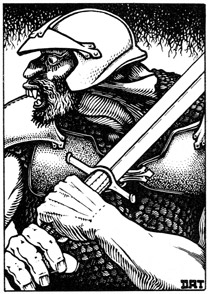 The defining visuals of the OSR are the original illustrators, many of whom are enjoying their own personal resurgence in popularity. Old school artists like Jim Roslof and David C. Sutherland (both, sadly, recently passed away), Russ Nicholson, David Trampier (a personal favourite—that’s his wonderfully graphic work on the left), Erol Otus, Jeff Easley, Jim Holloway and others are finding their somewhat naive but hugely evocative styles once more in vogue. OSR gamers are sick of the lifeless, ‘realistic’ perfection that passes for game art these days, and enjoy this old style of art that is so full of personal style and character. The new Dungeon Crawl Classics Role Playing Game, in particular, features an impressive roll-call of these classic artists, who quite literally defined the imaginative worlds of a generation of gamers. Even back then as a kid, I knew who these guys were and recognised each of their styles—who could say the same about most of the generic art pumped out by big game companies these days?
The defining visuals of the OSR are the original illustrators, many of whom are enjoying their own personal resurgence in popularity. Old school artists like Jim Roslof and David C. Sutherland (both, sadly, recently passed away), Russ Nicholson, David Trampier (a personal favourite—that’s his wonderfully graphic work on the left), Erol Otus, Jeff Easley, Jim Holloway and others are finding their somewhat naive but hugely evocative styles once more in vogue. OSR gamers are sick of the lifeless, ‘realistic’ perfection that passes for game art these days, and enjoy this old style of art that is so full of personal style and character. The new Dungeon Crawl Classics Role Playing Game, in particular, features an impressive roll-call of these classic artists, who quite literally defined the imaginative worlds of a generation of gamers. Even back then as a kid, I knew who these guys were and recognised each of their styles—who could say the same about most of the generic art pumped out by big game companies these days?
But there’s no future in wallowing in nostalgia, and those enamoured of the OSR, while understandably enjoying revisiting the vivid fantasies of childhood, are also looking to the future. New games are coming out that marry old approaches to gaming to simpler mechanics—for example the aforementioned DCC RPG. The idea is to tear roleplaying back out of the grasp of corporations and companies that want gamers to stay within the boundaries of the worlds they market and sell. Not to mention making roleplaying games playable again for those of us with families, mortgages and a frightening dearth of the endless spare time we had as teenagers. Roleplaying used to be about freedom to imagine anything. Care for a bit of science-fiction mixed in with your fantasy? Go for it. Don’t like the game worlds the companies have invented? Invent your own. Things in your imagination are inconsistent and ‘unrealistic’? Who cares! The important thing is to not worry about the rules so much: make it up as you go along, make a ruling on the spot, roll a dice on a table of random results. For someone like me, who has long been obsessed with preparing games long past the point of necessary effort, it’s a liberating return to the original goals of getting a few people together and making up stories in your collective imagination.
So if you’re getting a bit sick of the rules and restrictions, give the OSR a try. As I write, we’re gathering a party of adventurers, mixing old school rules and sensibility with the convenience of modern internet video conferencing technology, and descending into the Barrowmaze. How many will come out again—well, that remains to be seen …
Roleplaying Games D&D, Tekumel
19 Sep 12
 My role-playing game of choice for many years, on those rare occasions when a group of us old friends can engineer a break from our busy lives and organise a session (particularly rare now that I’m in another country) is Warhammer Fantasy Roleplay.
My role-playing game of choice for many years, on those rare occasions when a group of us old friends can engineer a break from our busy lives and organise a session (particularly rare now that I’m in another country) is Warhammer Fantasy Roleplay.
You’ll find the entertaining diary of our adventures from 1987 to the present here, should you wish to read it. I bought the first version of WFRP way back in 1986 and have forked out for every product in the line since, up to and including the new, and drastically different, version three (though, unfortunately, it seems it’s languishing somewhat these days in its new Fantasy Flight Games stable).
The one constant through the various versions of WFRP, however, has been the grim and perilous setting of The Empire, a roughly medieval Germanic fantasy land covered in dark, dangerous forests haunted by beastmen and torn apart from within by corrupt cultists and chaos-tainted mutants. The second edition of the game featured some beautiful maps by one Andrew Law, a talented cartographer whose atmospheric work really should be better known—and whose skills certainly should have been used for the new third edition.
Anyway, the point being of this ramble is that Mr Law has recently decided to recreate the entire Empire using Games Workshop’s plastic Mighty Empires’ terrain tiles, an enormous and frankly pretty crazy endeavour, but a gloriously ambitious one nonetheless. His progress is documented on his blog Lawhammer! I recently donated a set of tiles to help him on his way (you can read about it here and his dapper rendition of me by way of thanks is reproduced in this post) and already others are donating and bringing him very close to his goal of the 480-odd tiles required. Of course, keep in mind that he has to match the tiles to the actual map of the Empire, so there’s quite a bit of additional modelling required—including drilling river channels—to make the map accurate, not to mention painting them all as well.
When he’s finished, it should be an incredible thing of great beauty and wonderfully limited practical application. Sigmar’s blessings upon you Mr Law, go for it!
Roleplaying Games Warhammer, WFRP
07 Sep 12
As a new arrival from the stressy city of Sydney to the relaxed lifestyle of Nelson, New Zealand, I’m often surprised at what the locals take for granted. Little things, like being able to get a parking spot right next to where you want to be in town, or freakin’ huge things, like being able to head out for a day of skiing and be back in time for dinner.
Last week we thought we’d take advantage of what promised to be a gorgeous day, and drove one-and-a-half hours south to Rainbow ski field, a community-run ski area near St Arnaud village, on the edge of the Nelson Lakes National Park. Leaving the car at the lower car park, we climbed on board a mini bus for a slightly hairy 20 minute drive up to the skiing (the road is pretty rough). You can drive up yourself but you have to carry chains in case the weather takes a turn for the worse. But after seeing the native keas with their huge claws hop all over the parked cars (these large, intelligent native parrots apparently enjoy ripping the rubber seal from around your windshield too), I think I’ll continue to leave our car down in the lower carpark thanks.

I love skiing, but I very, very rarely get the opportunity to do it. In fact my last day on the slopes was about ten years ago in Colorado, USA, at Breckenridge. It seems every time I get to ski I just manage to get as good as I was the time before, then it’s a long, long break until the next opportunity. Well, with skiing like this only two hours away, I’m hoping I’ll finally get a chance to improve my skills.
That said, skiing is like riding the proverbial bike, and after a tentative start I was back on a decent slope. One semi-spectacular fall reminded me that you have to relax to ski properly, but surprisingly that was my only tumble all day, even later in the afternoon when I had a lesson that was, strictly speaking, above my current skill level, and skiied down from the top of the mountain twice. Going up on the T-bar, once you crest the first ridge, the ski field opens out into a spectacular vista of snow surrounded by a sharp line of mountain ridges and crowned by the bluest of skies. Beautiful.
To JoJo, it was all a completely new experience, but she bravely put up with my lame attempts at basic instruction and then had a one-on-one beginner’s class, and was snow ploughing down the beginner’s slope by the time the day was through. I was highly impressed; the first time on skiis can be a daunting challenge for anyone, something that’s hard to forget when you see three-year-olds swish past with utter confidence. Understandably, a lot of Kiwis from around here grow up on skis.
We left at closing time at 4pm, and were back at home by six. I’m hard-pressed to think of a better way to spend a day.
New Zealand skiiing
« Older Entries Newer Entries »
Page 3 of 33« First«...234...1015...»Last »
 My most recent boardgame graphic design job has hit the shelves: Aztlán by Italian publisher Ares Games (BoardgameGeek link). Like my last project of this type, Ninjato, I was lucky enough to be asked to work with evocative images by illustrator Drew Baker.
My most recent boardgame graphic design job has hit the shelves: Aztlán by Italian publisher Ares Games (BoardgameGeek link). Like my last project of this type, Ninjato, I was lucky enough to be asked to work with evocative images by illustrator Drew Baker.








 As part of the
As part of the  If you, like me, spent a good chunk of your formative years pitting your friends against horrific monsters, sending them into dank dungeons, inflicting damage, disease and insanity upon them, and generally acting like God on (Middle-) Earth, then I hope you too were playing Dungeons & Dragons and aren’t instead a rank psychopath now paying for your terrible crimes. A lot of people born in the sixties and seventies were doing the same, or the subjects of similar imaginative abuse as adventuring characters in a fantasy, sci-fi or historical world. D&D, and the many roleplaying games it spawned, were a big fad of the late 70s and 80s; but a fad with a far bigger impact on people’s lives than twirling a hula–hoop or spinning a yo-yo. There’s been nothing quite like role-playing games, before or since, and anyone who spent any serious time playing them will understand what I mean.
If you, like me, spent a good chunk of your formative years pitting your friends against horrific monsters, sending them into dank dungeons, inflicting damage, disease and insanity upon them, and generally acting like God on (Middle-) Earth, then I hope you too were playing Dungeons & Dragons and aren’t instead a rank psychopath now paying for your terrible crimes. A lot of people born in the sixties and seventies were doing the same, or the subjects of similar imaginative abuse as adventuring characters in a fantasy, sci-fi or historical world. D&D, and the many roleplaying games it spawned, were a big fad of the late 70s and 80s; but a fad with a far bigger impact on people’s lives than twirling a hula–hoop or spinning a yo-yo. There’s been nothing quite like role-playing games, before or since, and anyone who spent any serious time playing them will understand what I mean. We’re not talking about anything published ‘officially’ during the last couple of decades of increasing commercialisation and steadily encroaching blandness, of bad movies and cartoons and licenced toys, or of versions 2, 3, 3.5 (argh!), 4, and what is currently called D&D Next (triple argh!). We’re talking about three very early systems—the original ‘white box’ rules (just before my time), the old Basic Dungeons & Dragons sets (the original by J. Eric Holmes is where I came in—you can see the rulebook cover on the right), and the first edition Advanced Dungeons & Dragons hardcovers (‘AD&D’—the system I played the most). We’re talking everything up to about 1984, when the Dragonlance adventure modules came out and the original pulp science-fantasy origins of D&D began to be replaced by a kind of bland ‘American Tolkien’ fantasy melieu of buffed heroes, chainmail bikinis and Big Bad Guys. No, we’re talking getting a fighter, magic-user, cleric and thief together and descending into some monster-infested dungeon in search of gold pieces and magic items.
We’re not talking about anything published ‘officially’ during the last couple of decades of increasing commercialisation and steadily encroaching blandness, of bad movies and cartoons and licenced toys, or of versions 2, 3, 3.5 (argh!), 4, and what is currently called D&D Next (triple argh!). We’re talking about three very early systems—the original ‘white box’ rules (just before my time), the old Basic Dungeons & Dragons sets (the original by J. Eric Holmes is where I came in—you can see the rulebook cover on the right), and the first edition Advanced Dungeons & Dragons hardcovers (‘AD&D’—the system I played the most). We’re talking everything up to about 1984, when the Dragonlance adventure modules came out and the original pulp science-fantasy origins of D&D began to be replaced by a kind of bland ‘American Tolkien’ fantasy melieu of buffed heroes, chainmail bikinis and Big Bad Guys. No, we’re talking getting a fighter, magic-user, cleric and thief together and descending into some monster-infested dungeon in search of gold pieces and magic items. The defining visuals of the OSR are the original illustrators, many of whom are enjoying their own personal resurgence in popularity. Old school artists like
The defining visuals of the OSR are the original illustrators, many of whom are enjoying their own personal resurgence in popularity. Old school artists like  My role-playing game of choice for many years, on those rare occasions when a group of us old friends can engineer a break from our busy lives and organise a session (particularly rare now that I’m in another country) is
My role-playing game of choice for many years, on those rare occasions when a group of us old friends can engineer a break from our busy lives and organise a session (particularly rare now that I’m in another country) is 
Recent Comments